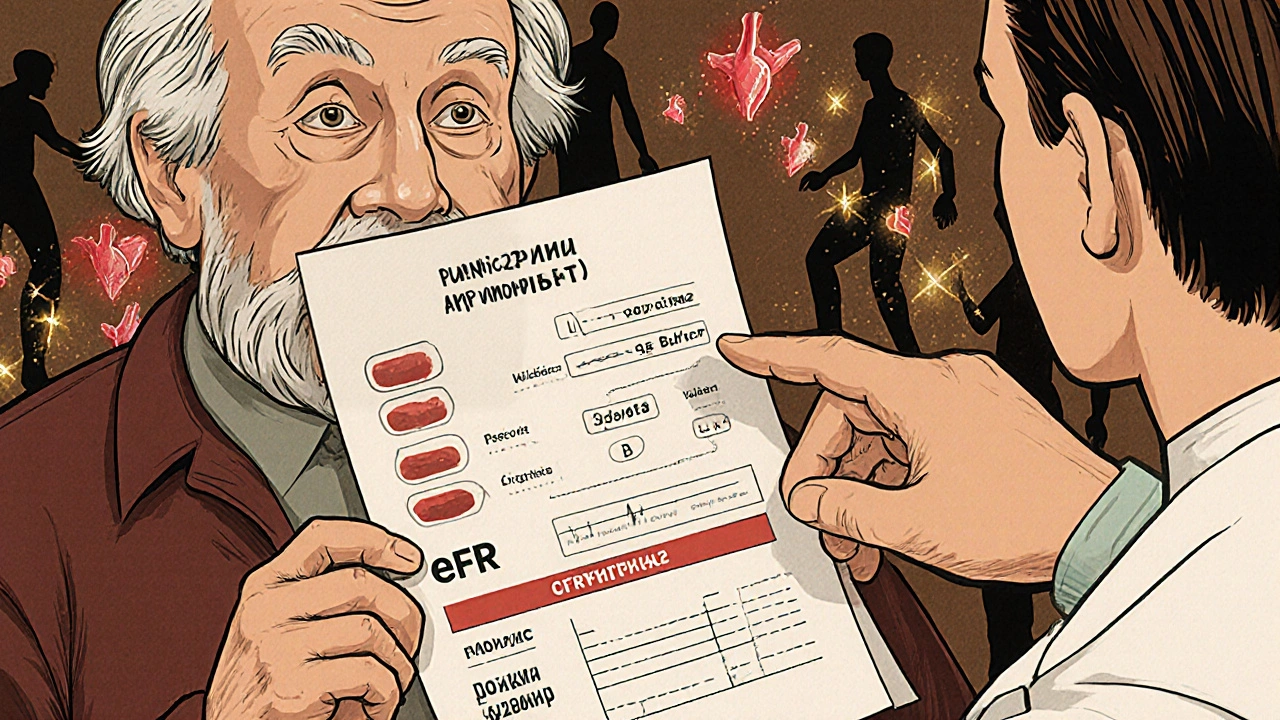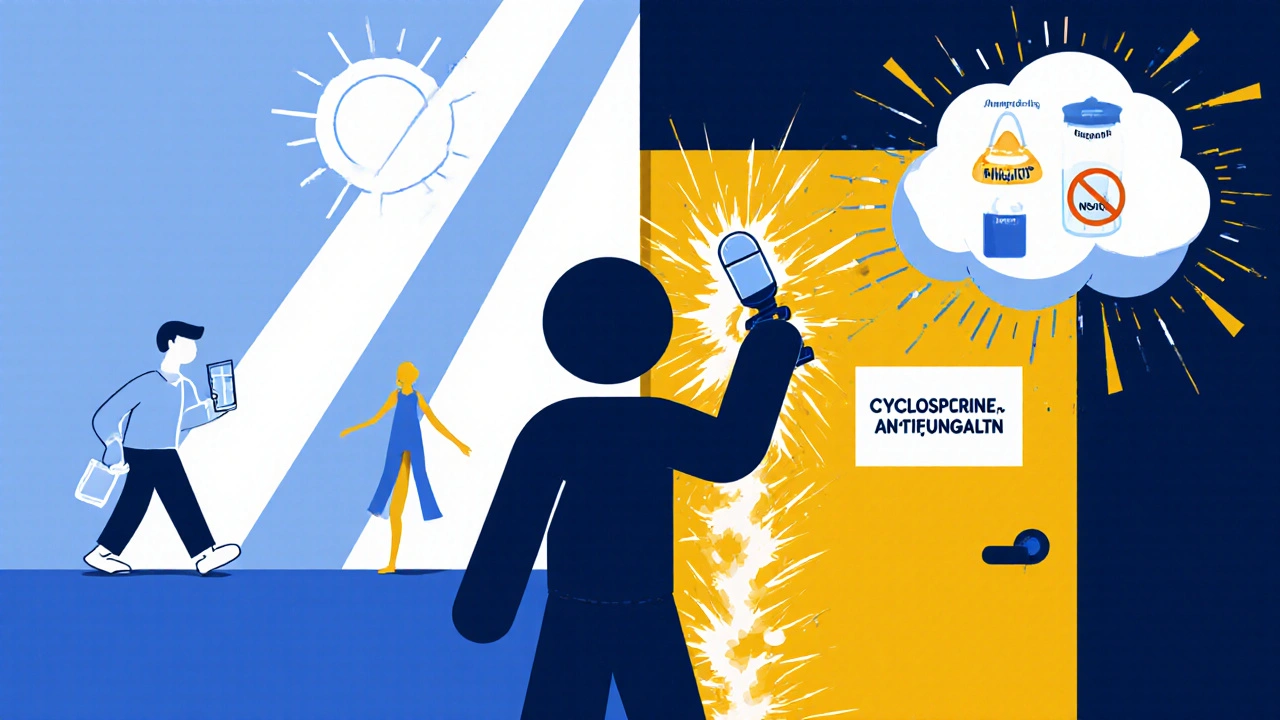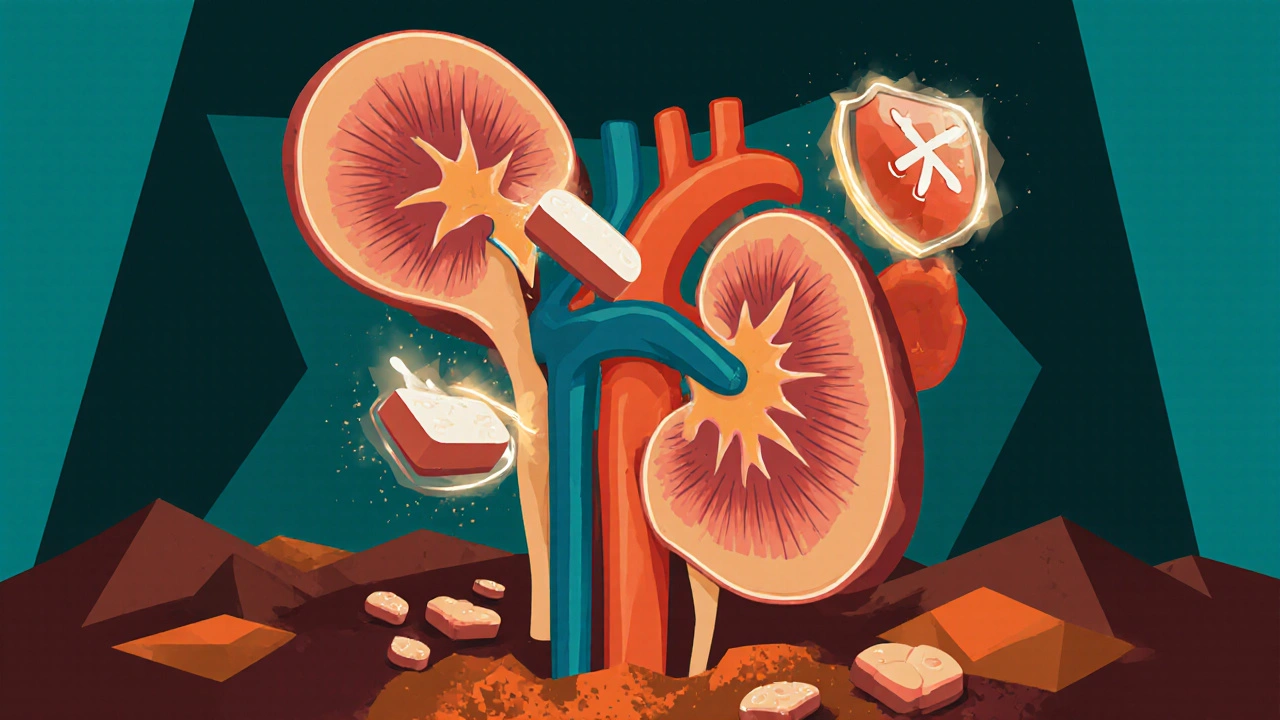Many people take atorvastatin to lower cholesterol and reduce heart disease risk. But if you have kidney issues-or are worried about them-you might be wondering: atorvastatin and kidney health, do they mix safely? The answer isn’t simple. It depends on your specific situation, your kidney function, and how your body handles the drug.
How Atorvastatin Works (And Why It Matters for Kidneys)
Atorvastatin is a statin, a class of drugs that blocks an enzyme your liver uses to make cholesterol. Less cholesterol in the blood means less plaque buildup in arteries, lowering your chance of heart attack or stroke. That’s the main goal.
But here’s the connection to kidneys: damaged kidneys don’t filter blood well. That means toxins and waste build up. High cholesterol makes that worse. In fact, people with chronic kidney disease (CKD) often have abnormal cholesterol levels-higher LDL, lower HDL. That’s why doctors often prescribe statins like atorvastatin to CKD patients, even if their kidneys aren’t working perfectly.
Studies show that in people with early to moderate CKD, atorvastatin reduces cardiovascular events by up to 25%. That’s significant. The kidneys don’t need to be perfect for the drug to work. But they do need to be monitored.
Does Atorvastatin Damage Kidneys?
No, atorvastatin doesn’t directly damage healthy kidneys. Unlike some antibiotics or painkillers, it’s not toxic to kidney tissue. The drug is mostly broken down by the liver, not filtered out by the kidneys. About 20% of atorvastatin leaves the body through urine; the rest goes through bile and stool.
That’s good news. It means even if your kidneys are weak, your body can still clear the drug. That’s why atorvastatin is often preferred over other statins like rosuvastatin or pravastatin in people with kidney disease. Rosuvastatin, for example, is cleared more by the kidneys-and can build up if kidney function drops below 30%.
But there’s a catch. While atorvastatin doesn’t harm kidneys directly, it can rarely trigger a serious side effect called rhabdomyolysis. That’s when muscle tissue breaks down and releases a protein called myoglobin into the blood. Myoglobin can clog kidney tubules and cause sudden kidney injury. This is rare-less than 1 in 10,000 people on statins-but it’s more likely if you’re taking high doses, have dehydration, are elderly, or already have kidney problems.
Who Should Be Careful?
Not everyone on atorvastatin needs to worry. But certain groups should be extra cautious:
- People with stage 3 or worse chronic kidney disease (eGFR below 45)
- Those over 70 years old
- People taking other drugs that interact with atorvastatin (like cyclosporine or certain antifungals)
- Anyone who’s dehydrated, has an infection, or just had major surgery
- Those with a history of muscle pain or weakness on statins
If you fall into one of these groups, your doctor will likely start you on a lower dose-maybe 10 mg instead of 40 or 80 mg. They’ll also check your kidney function before you start and every 3 to 6 months after.
What Tests Should You Get?
Your doctor will monitor two key things:
- eGFR (estimated Glomerular Filtration Rate)-this tells you how well your kidneys are filtering waste. Normal is above 90. Below 60 for three months means CKD.
- Creatinine levels-a waste product your kidneys remove. Rising levels can signal trouble.
- CK-MB and troponin-blood markers for muscle damage, if you report unexplained muscle pain.
- Liver enzymes-atorvastatin can affect the liver too, so these are checked alongside kidney markers.
You don’t need monthly blood tests. But if you’re on a higher dose or have other health issues, your doctor might test every 3 months. Once you’re stable, every 6 to 12 months is usually enough.

Signs Your Kidneys Might Be Affected
Most people on atorvastatin won’t have any kidney problems. But if you notice these symptoms, call your doctor:
- Swelling in your legs, ankles, or feet
- Feeling unusually tired or weak
- Reduced urine output or dark, foamy urine
- Unexplained muscle pain, tenderness, or weakness-not just soreness after exercise
- Nausea, vomiting, or confusion
These aren’t always about your kidneys. But when they happen together with atorvastatin use, they’re red flags. Don’t ignore them.
Can You Take Atorvastatin With Kidney Disease?
Yes-often, you should. The American Heart Association and the National Kidney Foundation both recommend statins for most people with CKD who are at risk for heart disease. That includes most people over 50 with CKD, even if they don’t have high cholesterol yet.
Why? Because heart disease kills more people with kidney disease than kidney failure does. Lowering cholesterol with atorvastatin can extend your life, even if your kidneys are already damaged.
A 2023 study in the Journal of the American Society of Nephrology followed over 12,000 adults with moderate CKD. Those who took statins had a 30% lower risk of heart attack or death over five years compared to those who didn’t. The benefit was strongest in people who kept taking the medication consistently.
So if your doctor says you should take atorvastatin, don’t refuse because you’re worried about your kidneys. The risks of not taking it are usually much higher.
What About Other Medications?
Atorvastatin plays well with most drugs. But some can increase the risk of side effects:
- Cyclosporine (used after transplants) - can raise atorvastatin levels dangerously
- Gemfibrozil (a fibrate for triglycerides) - increases muscle damage risk
- Some antifungals like itraconazole or ketoconazole
- Macrolide antibiotics like clarithromycin
If you’re on any of these, your doctor may switch you to a different statin or lower your dose. Always tell your doctor about every pill, supplement, or herb you take-even over-the-counter ones.

What If You Have to Stop Atorvastatin?
Some people stop statins because of muscle pain. But stopping without talking to your doctor can raise your heart risk fast. If you’re having side effects:
- Don’t quit cold turkey
- Ask about lowering the dose first
- Try switching to another statin like pravastatin or fluvastatin, which are gentler on muscles and kidneys
- Consider non-statin options like ezetimibe or PCSK9 inhibitors if needed
There’s no one-size-fits-all. But there are alternatives if atorvastatin doesn’t work for you.
What You Can Do at Home
Medication is only part of the story. Supporting your kidneys while on atorvastatin is just as important:
- Stay hydrated-drink water regularly, especially if you’re active or in hot weather
- Avoid NSAIDs like ibuprofen or naproxen-they stress kidneys and can interact with statins
- Watch your salt and protein intake if you have advanced kidney disease
- Don’t smoke-smoking speeds up kidney damage
- Control your blood pressure and blood sugar if you have diabetes
Small daily choices make a big difference over time.
Final Thoughts
Atorvastatin is not a kidney killer. It’s a heart protector-and for many people with kidney disease, that’s exactly what they need. The key is balance: taking the right dose, getting regular check-ups, and paying attention to your body.
If you’re on atorvastatin and have kidney concerns, talk to your doctor. Don’t assume it’s unsafe. Don’t assume it’s fine. Get tested. Get informed. And make a plan that fits your health-not someone else’s.
Can atorvastatin cause kidney damage?
No, atorvastatin does not directly damage kidney tissue. It’s primarily processed by the liver, not the kidneys. However, in rare cases, it can trigger rhabdomyolysis-a condition where muscle breaks down and releases substances that can clog kidney tubules. This is very uncommon and usually only happens with high doses, other interacting medications, or in people with existing kidney problems.
Is it safe to take atorvastatin with chronic kidney disease?
Yes, it’s often recommended. People with chronic kidney disease (CKD) have a higher risk of heart disease, and atorvastatin reduces that risk significantly. Guidelines from major health organizations support using atorvastatin in CKD patients, especially if they’re over 50 or have other cardiovascular risk factors. Dosing may be adjusted based on kidney function, but stopping the drug usually carries more risk than continuing it.
How often should kidney function be checked when taking atorvastatin?
Before starting atorvastatin, your doctor should check your kidney function with a blood test for eGFR and creatinine. After starting, testing every 3 to 6 months is typical, especially if you’re on a higher dose or have existing kidney disease. Once your levels are stable and you’re not experiencing side effects, testing every 6 to 12 months is usually sufficient.
What are the signs that atorvastatin is affecting my kidneys?
Atorvastatin doesn’t usually cause direct kidney symptoms. But if you develop unexplained muscle pain, weakness, or dark urine, it could signal rhabdomyolysis, which can harm the kidneys. Other signs include swelling in the legs, reduced urine output, fatigue, nausea, or confusion. These aren’t common, but if they appear, contact your doctor right away.
Can I take atorvastatin if I have stage 4 kidney disease?
Yes, but with caution. Atorvastatin is still considered safe in stage 4 kidney disease (eGFR 15-29), unlike some other statins. Your doctor will likely prescribe a lower dose, such as 10 mg daily, and monitor you closely. The benefits of reducing heart attack and stroke risk usually outweigh the risks, as heart disease remains the leading cause of death in advanced kidney disease.
Does atorvastatin interact with common kidney medications?
Atorvastatin can interact with certain drugs used for kidney conditions, especially cyclosporine (used after transplants) and some antifungal or antibiotic medications. These can raise atorvastatin levels in your blood and increase the risk of muscle side effects. Always tell your doctor about every medication, supplement, or herb you take-especially if you’re on immunosuppressants or dialysis.


Cecil Mays
October 29, 2025 AT 12:01Just started atorvastatin last month after my nephrologist said it’s safe for my stage 3 CKD. Been feeling better than ever-no muscle pain, no weird fatigue. Honestly, I thought I’d be on dialysis by now, but this med + walking 8K steps daily has been a game-changer. 🙌
Raj Modi
October 29, 2025 AT 13:59While the article accurately outlines the pharmacokinetics and risk stratification of atorvastatin in chronic kidney disease, I would like to emphasize the importance of longitudinal monitoring of urinary albumin-to-creatinine ratio (UACR), which is often overlooked in favor of eGFR alone. UACR provides an earlier and more sensitive indicator of glomerular endothelial dysfunction, particularly in diabetic nephropathy, where statin therapy is most commonly indicated. Furthermore, the interaction with cyclosporine is not merely a pharmacokinetic concern-it reflects a synergistic upregulation of hepatic CYP3A4 inhibition and P-glycoprotein suppression, which can elevate plasma concentrations beyond therapeutic thresholds even at standard doses. A 10 mg dose may be appropriate for eGFR <30, but individual variability in SLCO1B1 transporter polymorphisms necessitates pharmacogenetic screening in high-risk populations.
Sarah Schmidt
October 30, 2025 AT 08:42It’s funny how we’ve turned medicine into a numbers game-eGFR this, creatinine that, statin dose adjusted for kidney function like we’re coding a spreadsheet. But what about the human body? The liver doesn’t work in isolation, the kidneys aren’t just filters, and cholesterol isn’t some villain in a cartoon. We’re treating symptoms, not the root: inflammation, oxidative stress, insulin resistance. Atorvastatin might lower LDL, but it doesn’t fix why your liver overproduces it in the first place. Maybe we should be asking: why are we medicating people into a false sense of security instead of asking them to eat real food, sleep, and breathe?
Billy Gambino
October 31, 2025 AT 13:42The pharmacodynamic profile of atorvastatin, as a lipophilic HMG-CoA reductase inhibitor, exhibits preferential hepatic uptake via OATP1B1 transporters, thereby minimizing renal excretion-a key differentiator from hydrophilic analogs such as rosuvastatin. However, the concomitant use of conazole antifungals, particularly ketoconazole, induces a clinically significant pharmacokinetic interaction through CYP3A4 inhibition, resulting in a 3- to 5-fold increase in plasma AUC. While rhabdomyolysis remains statistically rare (≈0.01%), its pathophysiological cascade-myoglobinuria → tubular cast formation → acute tubular necrosis-represents a true medical emergency requiring immediate discontinuation and aggressive hydration. The literature, particularly the 2023 JASN cohort, demonstrates a number needed to treat (NNT) of 28 over five years to prevent one major adverse cardiovascular event in CKD patients, which, in a risk-benefit calculus, favors continued use. Nevertheless, the normalization of lipid parameters should not be conflated with vascular protection; endothelial function requires multimodal intervention.
Karen Werling
November 2, 2025 AT 04:16I’m a kidney transplant recipient on atorvastatin 10mg and honestly? I was terrified at first. But my care team was so clear and gentle about it. I drink water, avoid NSAIDs, and check in every 4 months. No muscle pain. No scary symptoms. Just peace of mind. 💙 Also-please, if you’re on this med, don’t skip your blood work. It’s not a burden, it’s your lifeline.
STEVEN SHELLEY
November 2, 2025 AT 12:55EVERYONE IS LYING ABOUT STATINS!!! THE PHARMA COMPANIES PAID THE DOCTORS TO SAY IT'S SAFE BUT THE REAL DATA IS HIDDEN IN THE FDA DATABASES!! I READ A BLOG POST FROM A GUY WHO LOST HIS KIDNEYS AFTER ATORVASTATIN AND THEY JUST COVERED IT UP!! THEY'RE USING YOUR KIDNEYS TO MAKE MONEY!! YOU THINK YOUR EGF IS NORMAL? IT'S A LIE!! THEY TEST IT WHEN YOU'RE SLEEPING!! I KNOW BECAUSE I WORKED AT A LAB!! YOU NEED TO STOP NOW BEFORE IT'S TOO LATE!!
Emil Tompkins
November 3, 2025 AT 12:57So you're telling me this drug doesn't hurt kidneys... but it might kill your muscles and then your kidneys? That's not a safety profile, that's a Russian roulette wheel with a 1 in 10000 chance of a bullet... and they call it preventative medicine? I mean, if I had a car that might explode if you drove it past 50mph, would you call it 'safe' if you told people to drive slow? No. You'd recall it. But hey, profits over people, right?
Kevin Stone
November 5, 2025 AT 07:41Interesting how the article mentions rhabdomyolysis as rare. But rare doesn’t mean impossible. And when it happens, it’s catastrophic. I’ve seen patients lose limbs from this. You can’t just say ‘it’s rare’ and move on. People need to be warned more clearly. Not just buried in a paragraph under ‘catch.’
Natalie Eippert
November 6, 2025 AT 09:40Why are we giving Americans statins like candy? In my country we don't just hand out pills to everyone over 50 because their cholesterol is a little high. We teach them to eat right and walk. This is why our healthcare system is so much better. You're all so quick to pop a pill instead of fixing your lifestyle. Shame.
kendall miles
November 6, 2025 AT 12:45They say atorvastatin is safe for kidneys... but what if the real danger is the blood tests? The needles, the labs, the data collection? What if the whole system is designed to keep you dependent? I’ve seen the charts-they track your eGFR to predict your death date. You think that’s for your health? No. It’s for insurance algorithms. They want to know when you’ll be a cost. Don’t trust the numbers. Don’t trust the doctors. Trust yourself.